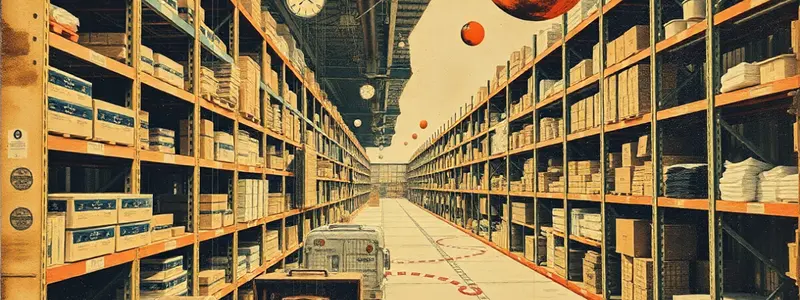Podcast
Questions and Answers
What is the main consequence of having less than the minimum stock level?
What is the main consequence of having less than the minimum stock level?
What are the two main factors that influence the minimum stock level?
What are the two main factors that influence the minimum stock level?
What is the term commonly used for the minimum stock level?
What is the term commonly used for the minimum stock level?
What is the role of the ROP (Re-order Point) in managing stock levels?
What is the role of the ROP (Re-order Point) in managing stock levels?
Signup and view all the answers
What is the significance of maintaining a close monitor of the minimum stock level?
What is the significance of maintaining a close monitor of the minimum stock level?
Signup and view all the answers
Who should be consulted when determining the minimum stock level?
Who should be consulted when determining the minimum stock level?
Signup and view all the answers
What is the main concern related to the procurement of materials with the ROP system?
What is the main concern related to the procurement of materials with the ROP system?
Signup and view all the answers
What is the potential consequence of maintaining an excessive minimum stock level?
What is the potential consequence of maintaining an excessive minimum stock level?
Signup and view all the answers
What factor should be considered when adjusting the minimum stock level in response to a mission surge?
What factor should be considered when adjusting the minimum stock level in response to a mission surge?
Signup and view all the answers
What is the primary objective of maintaining an adequate minimum stock level?
What is the primary objective of maintaining an adequate minimum stock level?
Signup and view all the answers
What is the purpose of establishing minimum levels, reorder points (ROP), and reorder quantities for high-use items?
What is the purpose of establishing minimum levels, reorder points (ROP), and reorder quantities for high-use items?
Signup and view all the answers
What is the significance of the 90-day period mentioned in the text?
What is the significance of the 90-day period mentioned in the text?
Signup and view all the answers
What is the primary objective of the Min/Max Level formula?
What is the primary objective of the Min/Max Level formula?
Signup and view all the answers
What does the reorder quantity represent in the context of inventory replenishment?
What does the reorder quantity represent in the context of inventory replenishment?
Signup and view all the answers
What factor can influence the reorder quantity for an item?
What factor can influence the reorder quantity for an item?
Signup and view all the answers
What is the relationship between the reorder point (ROP) and the reorder quantity?
What is the relationship between the reorder point (ROP) and the reorder quantity?
Signup and view all the answers
How does the NexGen system support inventory management in this context?
How does the NexGen system support inventory management in this context?
Signup and view all the answers
What is the importance of coordination and discussion between MC and the maintenance shops regarding high-use items?
What is the importance of coordination and discussion between MC and the maintenance shops regarding high-use items?
Signup and view all the answers
Study Notes
Maintenance Stock Management
-
Collaboration: Maintenance shops and Materiel Control (MC) coordinate to determine what high-use items should be stocked in the main store. Shops are best informed about repetitive needs.
-
Minimum Stock Level: Stocks must be sufficient for 90 days of routine maintenance. Maintenance items are ordered if on-hand quantities reach the Reorder Point (ROP). This strategy prevents urgent procurements.
-
Setting Stock Levels: NexGen software enables MC to set ROPs, reorder quantities, and minimum levels.
Minimum/Maximum (Min/Max) Level
- Min/Max: A specific level for replenishing inventory, aimed at optimizing total ordering costs. It focuses on finding the optimal order quantity to minimize warehousing space, stockouts, and overstock costs.
Reorder Quantity
-
Reorder Quantity: The number of units ordered in a replenishment Purchase Order. The ideal quantity balances preventing over-ordering and potential stockouts.
-
ROP Formula: ROP is calculated by adding expected lead time requirements to safety stock. It should be adjusted if manufacturing/sales prices are changing.
Minimum Level
-
Minimum Level: The quantity that must remain in stock. Low stock levels can lead to work stoppages due to material shortages. Minimum levels are also referred to as safety stock.
-
Factors of Minimum Stock Considerations: Average material consumption rates, time for priority procurements, reorder levels, production needs, advantageous procurement quantities are factors considered.
-
Recommendations for Minimum Level: When adjusting minimum stock levels consult maintenance shops on anticipated changes to operations, especially long-term changes.
-
NexGen Functionality: NexGen software can automatically generate purchase requests (PRs) for reorder items, streamlining the replenishment process. MC can set up automatic stock replenishment for the main store.
Stock Monitoring
-
Stock Monitoring: MC needs to monitor constantly the amount of each stocked item to ensure availability for immediate issuance. Adjustment to quantities can be made based on recorded consumption records.
-
Stock Adjustments: Recorded consumption may necessitates adjustments in the maintain quantity. MC must consult with shops before any actions that impact on-hand stock to allow for mission changes.
-
Impact of Stock Levels: Insufficient stocking, inability to provide stocked items, or missed required delivery dates result in stock outs and delay of mission completion.
-
Surge in Demand: If a surge in material requirement is not anticipated to be permanent, then the decision is to raise or maintain the current amount of stock according to long-term needs, procurement lead times, and cost.
Stock Optimization
- Excessive Stock Levels: If stock levels exceed requirements, MC can work with shops to reduce maintenance.
Studying That Suits You
Use AI to generate personalized quizzes and flashcards to suit your learning preferences.
Description
This quiz covers the principles of maintenance stock management, focusing on collaboration between maintenance shops and Materiel Control, minimum stock levels, and order quantities. Gain insights into optimizing inventory management through effective stock level settings and reorder strategies.




